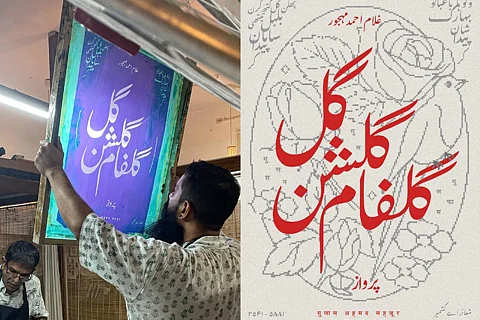
- HOMEGROWN WORLD
- #HGCREATORS
- #HGEXPLORE
- #HGVOICES
- #HGSHOP
- CAREERS
- ABOUT US
- CONTACT US

A young artist from Bombay, Yash Prajapati is a visionary who utilises the ordinary elements around us to craft a dynamic tale of type and print. Someone who views art through a multidimensional gaze, he often selects inspirations from the country’s rich heritage, past and present pop-culture references.
Feeding his curiosity through exploring uncharted areas of design, Yash attempts to visualise typography through unique perspectives. Even learning new scripts and languages in order to achieve an authentic outcome. Sharing some of the influences and inspirations behind his work, Yash spoke to Homegrown about his ongoing journey as an artist.
What are some of your biggest influences as an artist?
Street typography, Hand-painted street signages, Old movie posters, Vinyl cover art, Pizza boxes, Matchboxes, Vintage packaging, Postage stamps, Neon pamphlets etc are the things that have influenced me as an artist.
Who are some artists who are currently on your radar?
Wael Morcos, G.R Santosh, Kunel Gaur & Kiel DM
A project you wish you were a part of?
I can't think of a particular project at the moment but would definitely like to redesign Mumbai City Signage system, if given an opportunity by Brihanmumbai Municipal Corporation or by Govt. of Maharashtra
What are some things you learned while putting this project together?
To be more patient and enjoy the process rather than worrying about the end result. Also to keep on exploring and experimenting with different print mediums.
Tell us about your project.
My project 'Gul Gulshan Gulfaam' is a tribute to the Kashmiri Poet 'Ghulam Ahmad Mehjoor' and to the music band 'PARVAAZ'.
I first heard PARVAAZ live sometime around 2018 and have since been a fan of their incredible music. Here's an attempt at visually translating my favourite song of theirs 'Gul (Flower) Gulshan (Garden) Gulfaam (Gardener)' from the album 'BARAN'.
This poem was originally written by Peerzada Ghulam Ahmad 'Mehjoor' who is known as the 'Poet of Kashmir'. In it, Mehjoor refers to Kashmir as a Garden, her citizens as the Gardener and implores them to restore its grandeur and beauty.
Composed, sung and brought to bloom by Khalid Ahmed (Parvaaz) Originally in Koshur (Kashmiri) with translation in English:
Walo ha Baagwano (Come forth, Gardener)
Nov bahaaruk shaan paida kar (Create the magnificence of a new spring)
Pholan Gul gath karan Bulbul (The flowers would bloom, with songbirds circling around them)
Tithuy samaan paida kar (Create things like this)
What are some of your biggest inspirations over the years of your artistic career?
I’ve always carried a deep love for the Urdu language, not just for the beauty of its sounds but also because the intricate nature of the script (Nastaliq) that appeals to the typography nerd in me. These days I am learning to read and write it as well. Even though I am not very fluent, it gives me a long-term goal to work towards.
I also admire some artists who I have been lucky to interact with in real life, these relationships are very rewarding as they provide me an opportunity to understand how their lives and pasts inspire the art. Lastly, outside in the streets, I find myself drawn to signage and street posters that call back to the unique hand-lettering previously used in retro Bollywood movie posters.
Describe your creative process and the purpose with which you create.
I try not to bog myself down into a process very early during the brief and try to visualise it from various angles. What helps me get started is a clear understanding of ‘what not to do’, which for me is following an obvious path or attempting things that are in “vogue” at any given time. For example, if I am working on an organic ice cream brand, I know 'Cooper Black' is the trend these days for such brands and so I will try to avoid it. This helps achieve two things at once: It helps me deliver work that will help the client stand out and also helps me avoid stagnation.
Once I have decoded the brief, I experiment with basic concepts. This is where I mix my initial explorations with inspiration from the work I see on a day-to-day basis. Once I find a thread that looks promising and right for the brief at hand, I start giving it more shape. The objective is always to create something that looks great but also makes sense as a design output while pushing the limits of the brief...
For my personal projects, however, inspiration comes a bit spontaneously. For instance on this project, I really liked the verse from the poem at a deep personal level. Which led me to create a visual around it and later also getting it screen-printed.
Explore his work here.
